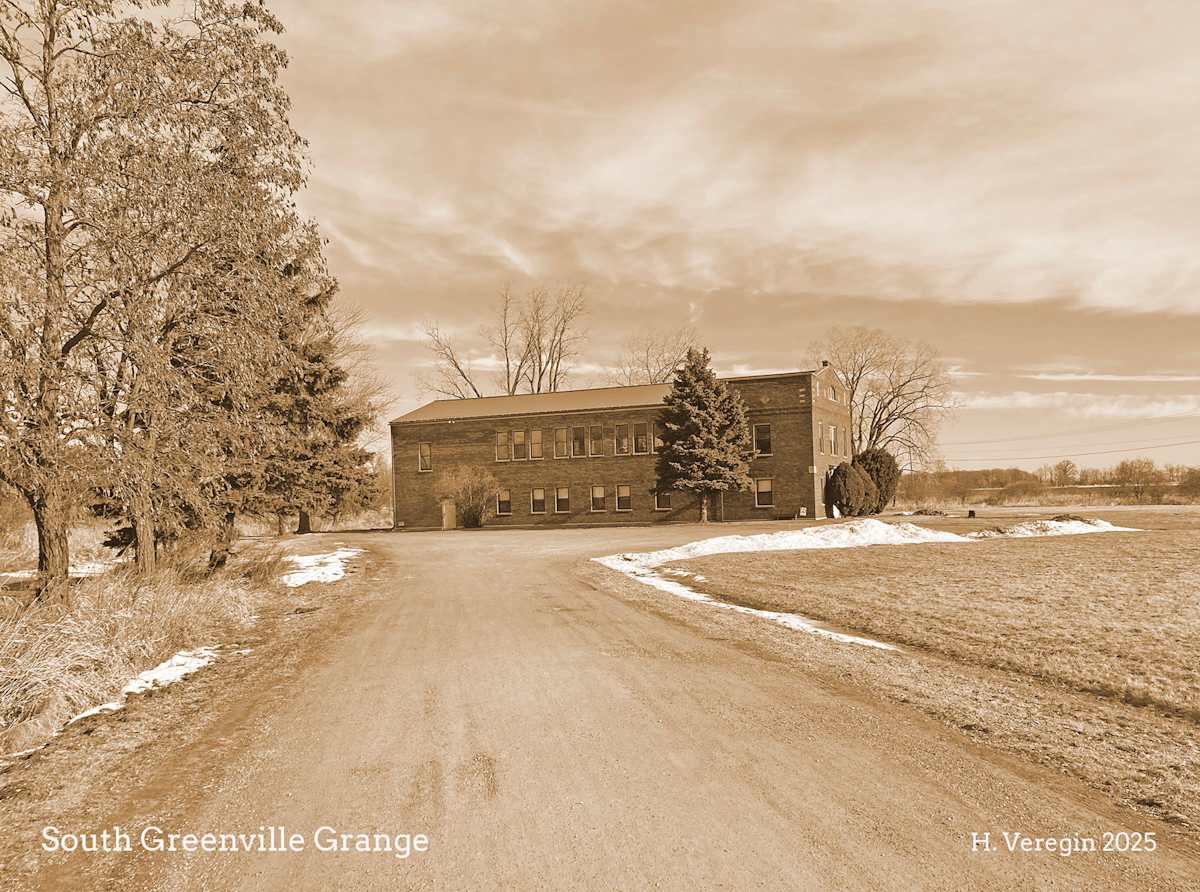South Greenville Grange, also known as Grange No. 225, is the oldest continuously active Grange in Wisconsin. Organized on October 24, 1873, it is one of over five hundred Granges that once dotted the state. [1] The Grange Hall, built in 1928, sits at the corner of State Hwy 76 and County Road BB in Outagamie County. The two-story brick building is the fifth in a series, each one larger than its predecessor. [2]
South Greenville Grange Hall is listed in the National Register of Historic Places due to its association with the National Grange organization, also known as the Order of the Patrons of Husbandry. The National Grange was established in Washington DC in 1867, a few years after the end of the Civil War. It was conceived as a progressive organization to promote social interaction among farm families and provide opportunities to learn about modern farm practices.
Local subsidiaries of the national organization were known as Granges, a word historically used in Britain to denote a farm estate. At the zenith of the National Grange movement in the mid-1870s, there were 20,000 Granges nationwide with a membership of 800,000. From the inception of the organization, women had full membership alongside men. [2]
A few years after its founding, the National Grange became involved in political lobbying due to its staunch opposition to the price fixing and monopoly practices of railroad and elevator (grain storage) companies, on which farmers depended to store and ship their crops. [3] Grangers argued that the railroads and elevators (often owned by the railroads) held too much power, could fix prices without recourse, charged exorbitant prices for their services and were able to unfairly eliminate smaller competitors. The National Grange set out to curb these practices.
These problems were intensified by the financial panic of 1873, the onset of two decades of economic uncertainty known as The Long Depression. [4] [5] The 1873 crisis was sparked when European investors began to sell off their foreign investments, particularly US railroad bonds. With a glut of bonds on the market, railroad companies could no longer secure investment capital, and many went bankrupt. As they struggled to stay afloat, the railroads were unwilling to lower their prices, even as the crisis affected farm commodity prices and the fees small farmers were able to pay.
Granger Laws were passed in four midwestern states – Illinois, Iowa, Minnesota and Wisconsin – to set limits on the tariffs railroads could charge. Wisconsin’s so-called Potter Law is generally considered the harshest of the Granger Laws. Wisconsin’s governor, William Taylor, a prominent Grange member, was a strong supporter of the law. It fixed maximum rates for railroad freight, gave justices of the peace jurisdiction to hear complaints and appointed a Railroad Commission with the power to examine railroad company financial records. [6]
The Potter Law was unpopular with railroad companies, who declared it unconstitutional because it destroyed their earning power. Legal battles followed, and the law was soon repealed, even though the US Supreme Court ultimately upheld the right of the state to regulate railroad rates.
Conventional wisdom suggests that the Potter Law nearly destroyed the railroad industry in Wisconsin, bringing railroad construction to a standstill. Charles R. Detrick, writing in the Journal of Political Economy in 1903, showed these claims to be false, demonstrating that, “The granger acts appear in fact to have had very little effect on rail-road building and railroad receipts, because of the overshadowing influence of the financial panic of I873 and the depression which lasted till I879.” [7] His analysis proved that the Granger states suffered less than the United States as a whole. The problem the railroads faced was the financial crisis, not the Grange movement.
The Grange is still an active organization, with a mission to strengthen “individuals, families and communities through service, education, nonpartisan grassroots advocacy and agricultural awareness.” [8] They continue advocacy work on issues important to rural communities, such as high-speed broadband, healthcare, school quality, crop insurance, mail delivery and global trade. [2]
The South Greenville Grange Hall has been a part of the local community for almost one hundred years. By the early 20th century, the Grange had about 200 members. The Grange Hall hosted dances, plays, weddings, ball games, flea markets, bake sales and picnics. A cooperative store carried groceries, seeds, feeds, farm supplies, fuel and other commodities. The Grange established the Greenville Cooperative Gas Company in 1931 and the Greenville Frigid Locker Plant in 1939. [2]
If you want to step back in history and get a taste of the Granger Movement, the South Greenville Grange can be rented for weddings, parties, dances and other events. [9]
Want to be the first to be notified of new Oddsconsin posts? Sign up for email alerts here.
Sources:
[1] South Greenville Grange No. 225, Historical Marker Database. https://www.hmdb.org/m.asp?m=3716
[2] South Greenville Grange National Register of Historic Places Nomination. https://npgallery.nps.gov/GetAsset/493291c4-4879-498b-80f4-e68f408f6992
[3] The Granger Revolution, Stanford University Engineering. https://cs.stanford.edu/people/eroberts/cs181/projects/corporate-monopolies/dangers_grangers.html
[4] Financial Panic of 1873, US Department of the Treasury. https://home.treasury.gov/about/history/freedmans-bank-building/financial-panic-of-1873
[5] The Long Depression and the Panic of 1873, Federal Reserve Bank of New York. https://libertystreeteconomics.newyorkfed.org/2016/02/crisis-chronicles-the-long-depression-and-the-panic-of-1873/
[6] Potter Law, Wisconsin Historical Society. https://www.wisconsinhistory.org/Records/Article/CS1739
[7] Charles R. Detrick, 1903, The Effects of the Granger Acts, Journal of Political Economy, 11 (2): 237–256. https://www.journals.uchicago.edu/doi/10.1086/250935
[8] Mission and Vision, National Grange of the Order of Patrons of Husbandry. https://www.nationalgrange.org/about-us/vision/
[9] South Greenville Grange #225. https://www.greenvillegrange.com/
